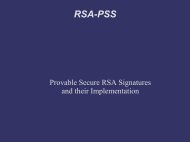RSA-PSS â Provably secure RSA Signatures and their ...
RSA-PSS â Provably secure RSA Signatures and their ...
RSA-PSS â Provably secure RSA Signatures and their ...
Create successful ePaper yourself
Turn your PDF publications into a flip-book with our unique Google optimized e-Paper software.
<strong>and</strong> physics where today very little is known at all. So while what would berequired for “provable security” is in theory imaginable, it is unlikely to happenany time soon.12 Conclusion12.1 Difficulties in deploying better CryptographyIn theory, we’d like to see the best cryptography that is available used withinreal world applications. In practice, this is often not the case – often enough,what’s used is just “what’s not completely broken yet” <strong>and</strong> widespread adoptionwaits until real-world attacks can be shown in practice.We saw that the <strong>PSS</strong> padding provides better security in certain circumstancesthan old padding methods like PKCS #1 v1.5. However, adoption of<strong>RSA</strong>-<strong>PSS</strong> is widely lacking. What we can see here <strong>and</strong> also with similar examples(like the transition from MD5/SHA-1 to SHA-2) is that it seems to bevery hard to deploy improvements from theoretical cryptographic research topractical applications.For an algorithm to be used, it usually has to pass several obstacles:1. The algorithm has to be developed, examined <strong>and</strong> accepted by the cryptographiccommunity.2. The algorithm primitives have to be st<strong>and</strong>ardized.3. High level protocols using those primitives need to be st<strong>and</strong>ardized.4. The st<strong>and</strong>ards need to be implemented in libraries <strong>and</strong> applications, boththe primitives <strong>and</strong> the high level protocols.5. Finally, they need to be used <strong>and</strong> set as the default within applications.<strong>RSA</strong>SSA-<strong>PSS</strong> is mostly stuck between 2 <strong>and</strong> 3. But even when looking atthe example of SHA-2, it is in many cases stuck between 3 <strong>and</strong> 4, althoughreal-world attacks are expected within the next couple of years.One of the most often cited reasons not to switch to better algorithms isbackwards compatibility. As an extreme example, within the browser marked,it usually can be expected that rarely anyone will adopt anything that is notbackwards compatible to browsers several years old (the argument I hear mostoften when asking for signatures using SHA-2 instead of SHA-1 is that WindowsXP before SP3 does not support that). So even if at some point all browserssupport X.509 certificates with <strong>RSA</strong>SSA-<strong>PSS</strong>, it is unlikely that any majorcertificate authority will use them any time soon.But that does not explain why it also seems to be very hard to deployimprovements on the st<strong>and</strong>ards level. As we have seen, <strong>PSS</strong> has not been47



